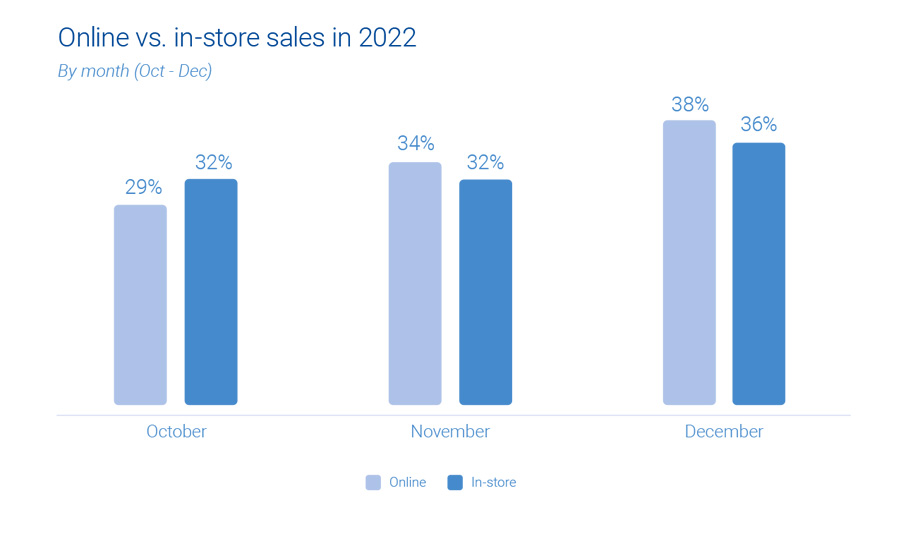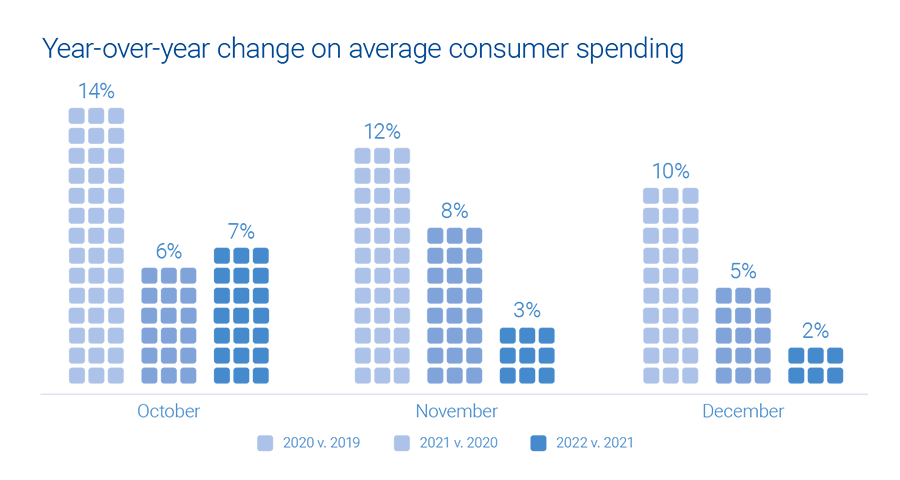
The holiday season is just around the corner, and retailers and marketers are gearing up for the busiest shopping period of the year. It’s crucial to understand how consumer behavior is evolving and what emerging trends to expect. Experian’s 2023 Holiday spending trends and insights report analyzes recent trends, consumer spending habits, and anticipates what’s to come in 2023 to help you deliver a top-notch shopping experience this holiday season.
In this blog post, we’ll cover three key insights from our report.
1. Consumers are shopping earlier
It’s no secret that December has always been the go-to month for consumers when it comes to holiday spending. However, holiday shopping now starts earlier, particularly with online sales.

This can be attributed to a surge in promotions and deals, enticing shoppers to open their wallets ahead of time, giving a significant boost to holiday sales. Notably, Cyber Week sales have proven to be an influential factor, accounting for 8% of total consumer holiday spending.
Experian tip
Reach the right shoppers with your promotions with sell-side targeting. This powerful approach gives you control over where your ads are placed while ensuring maximum visibility through direct connections with publishers. Whether on mobile, web, or CTV, this seamless ad experience will engage your audience effectively.
2. Online sales are on the rise
The popularity of online holiday sales is continuously growing, surpassing in-store shopping. There has been a consistent 1% year-over-year increase in online sales, while in-store sales have seen a 1% decrease.
“It’s easier for consumers to comparison shop for large ticket items online that they might find at a mass retailer or office supply store. Consumers prefer to have larger, bulkier items shipped directly to their home for minimal cost. By shopping online, consumers can save time since they don’t need to wait in checkout lines.”
Anna Liparoto, Sr. Account Executive, Retail & CPG

Although online sales currently make up only one-third of all holiday shopping, there is immense potential for further expansion. Mass retailers and office, electronics, and games industries particularly excel in online holiday sales. While in-store purchases remain the primary choice for holiday shoppers, consumer online and offline activities intersect before the final purchase.
Experian tip
Take advantage of the surge in online shopping by diversifying your marketing channels. An agnostic identity graph can bring together device and media data, capturing valuable user insights. By gaining a holistic view of your target audience, you’ll be able to optimize your ad spend and allocate resources effectively, ultimately boosting your return on investment.
“Omnichannel targeting during the upcoming holiday season will continue to prove to be the best way to reach scale and maximize ROI across all marketing channels.”
Joe Ligé, Head of Enterprise Demand Partnerships
3. 2023 holiday spending will be on par with 2022
During the holiday season in 2022, consumer spending showed an anticipated increase, although the growth rate was slightly lower compared to previous years. October saw a surge in average consumer spending, indicating a swift response to early discounts and promotions offered by retailers.

As the holiday season progressed, holiday spending gradually slowed down and reached a level similar to that of the previous year. Overall, there was a modest 2% growth. Looking into the future, if economic conditions remain stable in the second half of 2023, we can expect holiday spending to align with the figures from last year.
Experian tip
To truly maximize impact, consider data enrichment. By diving deeper into your target audience’s preferences and behaviors, you can better tailor your strategies and seamlessly integrate the enriched data across various channels. This allows you to unlock the true potential of your ad inventory, creating more meaningful connections with your audience.
Download our new 2025 report
Get ready for the holiday shopping season with Experian’s 2025 Holiday spending trends and insights report, in collaboration with GroundTruth. Inside you’ll find:
- When shoppers plan to buy
- Why stores still drive results
- Where marketers are placing their bets
- How AI is shaping discovery
To access to all of our predictions for this year’s holiday shopping season, download our 2025 Holiday spending trends and insights report today.
Contact us today
Latest posts

Welcome! Who doesn’t like a warm welcome? Whether your customer is walking into your store or just signed up on your website to receive communications from you, she expects a warm reception. It’s important to make that first impression count. A welcome series helps the conversation open up between the customer and your brand. It sets expectations on the types and cadence of content the customer will receive. Welcome emails also garner 86 percent higher open rates than regular promotional mailings – not too shabby! In a recent webinar, Saks Fifth Avenue shared that they are constantly testing new and current programs to optimize the customer experience. As a result, they discovered that switching from batch-sending welcome emails to sending welcome messages in real time increased open, click and redemption rates significantly. Here’s an example of their welcome series: Saks’ results are consistent with Experian Marketing Services’ welcome email findings which indicate that emails triggered in real time receive up to 10 times the transaction rates and revenue per email vs. those that are batched. A welcome series has also been shown to increase retention by educating customers on new ways to use products and services they’ve purchased from your brand. These emails also can remind customers of the benefits they’ll reap from enrolling in your loyalty programs or credit card. … and welcome back Even if a customer has been welcomed and has interacted with your programs, a day may come when the customer goes silent. Reactivation campaigns are an effective way to get them to re-engage. Naturally, it’s important to target your dormant customers in a variety of channels so you can reach them more effectively. Maybe you’re wondering why I jumped from the warmth of a welcome series right into reality of needing a reactivation campaign. The reason? Marketers need to understand where a customer is in their lifecycle and come full circle with customers if they have parted ways. Marketers can pique the interest of a returning customer by telling them what’s new and reintroducing them to their brand. Carnival® Cruise Lines, for example, sends a welcome-back email that features the newest social networks, offers and deals its customers can take advantage of immediately. At the end of the day, customers expect to receive relevant and engaging messages throughout their entire relationship with a brand. Customer life cycle programs deliver just that. If you’re interested in learning more about welcome campaigns, waitlist/back-in-stock programs and other remarketing strategies, check out our webcast, Driving revenue through customer lifecycle marketing featuring Josh Pratt, Director of Email & Promotions for Saks Fifth Avenue and Saks Fifth Avenue OFF 5TH. Contact us today

It seems that every time I go into a store today, I am offered a loyalty card. From one of my favorite local restaurants to my shoe store VIP program, I feel like I am getting a host of emails and points at every turn. Statistics support my theory: according to a recent Experian Data Quality study, 91 percent of organizations use loyalty programs. Why did they become so prevalent? Today’s consumer is more empowered than ever before and driving major change within business. In the era of Yelp, digital channels and a 24/7 shopping cycle, organizations have less control. Just look at the shoe market, which you can tell I pay attention to. It used to be that you would purchase whatever your local department store or brick-and-mortar retail had to offer, which might be 50 different options. Now, you can go online, read reviews and browse hundreds of different choices based on style and color. In fact, last night I went online and searched for black boots and scrolled through six pages of different options! Loyalty programs are a counter balance to that choice and empowered customer behavior. They make sure that while I am shopping for shoes, I am probably doing it through my preferred store and earning reward points for free merchandise. And through the loyalty process, companies are collecting a lot of data. Customers usually need to provide more than three types of information to sign up, the most popular being email, followed by name and phone number. However, collecting this information accurately isn’t always easy, which is why poor data collection is one of the leading problems for loyalty programs. Eighty-one percent of companies face challenges related to these programs, the two biggest being not enough customers signing up and poor contact data. Inaccurate data means that a customer has signed up, but the marketer is unable to communicate with them in the desired channels. This clear drop in communication and a potentially bad customer experience could be by improved data collection. Sixty-four percent of respondents say this is a needed improvement. Let’s go back to my shoe retailer example. If they had collected my email wrong, I wouldn’t get my email confirmations or offers around upcoming sales. If they got my address wrong, I wouldn’t be receiving my shoes. Considering how much money I spend on shoes annually, which I am ashamed to admit, if any of those items went wrong, I might switch to a competitor. That can equate to a lot of money annually, especially when you look at it across a large number of clients. When a customer chooses to sign up for a loyalty program, they are making a commitment to the company and expecting something in return, be it points, free shipping, coupons or just company updates. However, if bad contact information is collected, then the consumer often never receives the benefits, resulting in a bad customer experience. In the next year, marketers need to data validation in place to ensure information is accurate upon collection. This type of software can be implemented across all channels where information is collected and ensure data is accurate while the consumer is still engaged. If information is accurate when it is collected, then loyalty programs have a better chance at engaging consumers and actually seeing the benefit that a loyalty program can provide. To learn more about loyalty programs and the research mentioned above, please read our new white paper, Driving customer loyalty. Contact us today

Black Friday online traffic increased 7% in 2012 versus 2011 as the top 500 retail sites received more than 193.8 million total US visits. So far this Holiday week of online traffic to the top retail sites is up 10% on average. Online retail traffic was up 1% on Black Friday compared to Thanksgiving Day 2012 traffic this year. Amazon.com remained the top visited retail site on Black Friday while Walmart was the second most visited retail site. BestBuy moved up to the 3rd most visited site while Target was the 4th most visited site. JC Penney moved up from being the 8th most visited retail site on Thanksgiving Day to the 5th most visited on Black Friday. Among the top 5 sites, JC Penney saw the biggest day-over-day growth at 26%. Looking at the top 20 retail sites on Black Friday, the Apple Store site saw the biggest day-over-day growth at 99%. Check back for CyberMonday insight and a weekly recap of this week. Contact us today